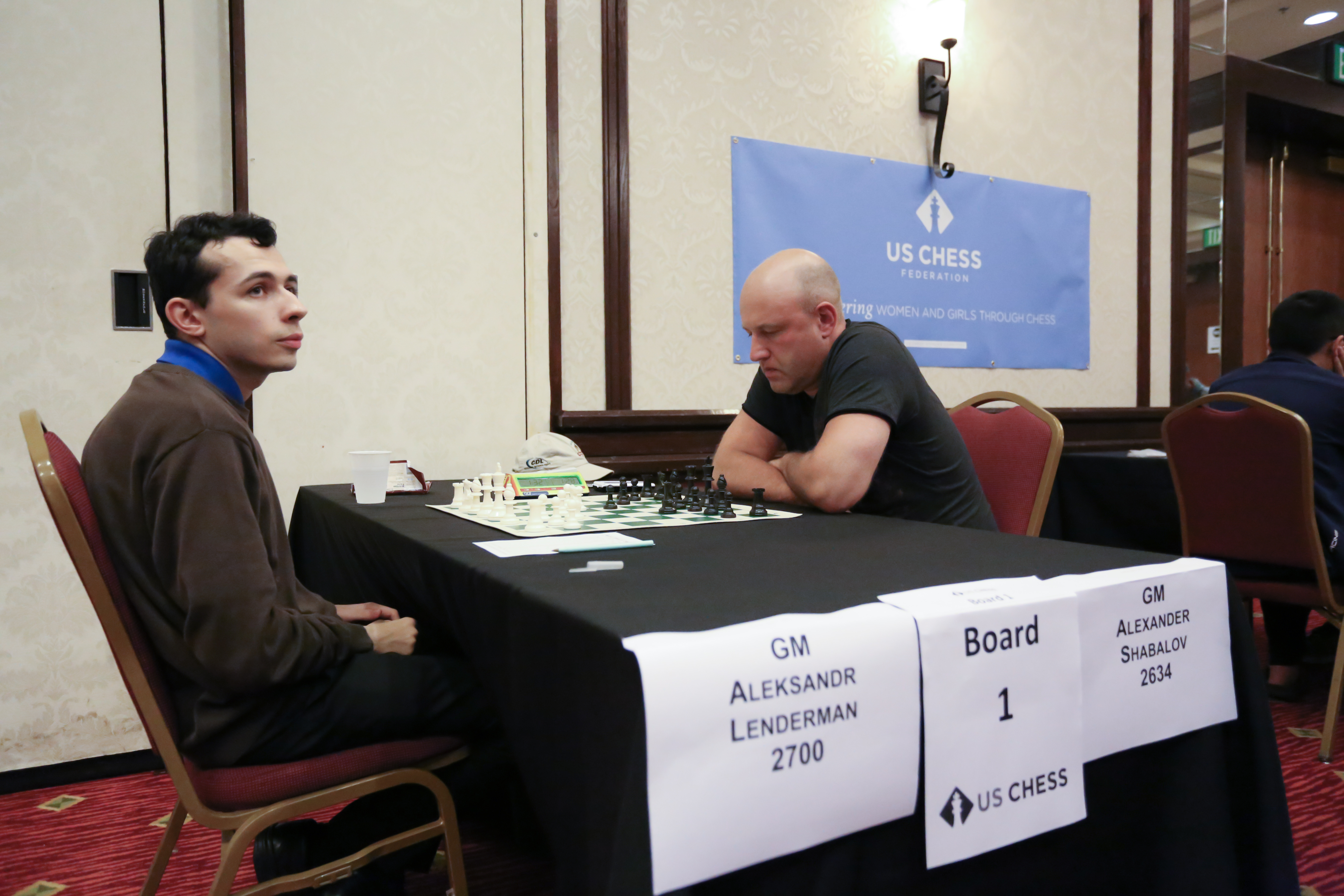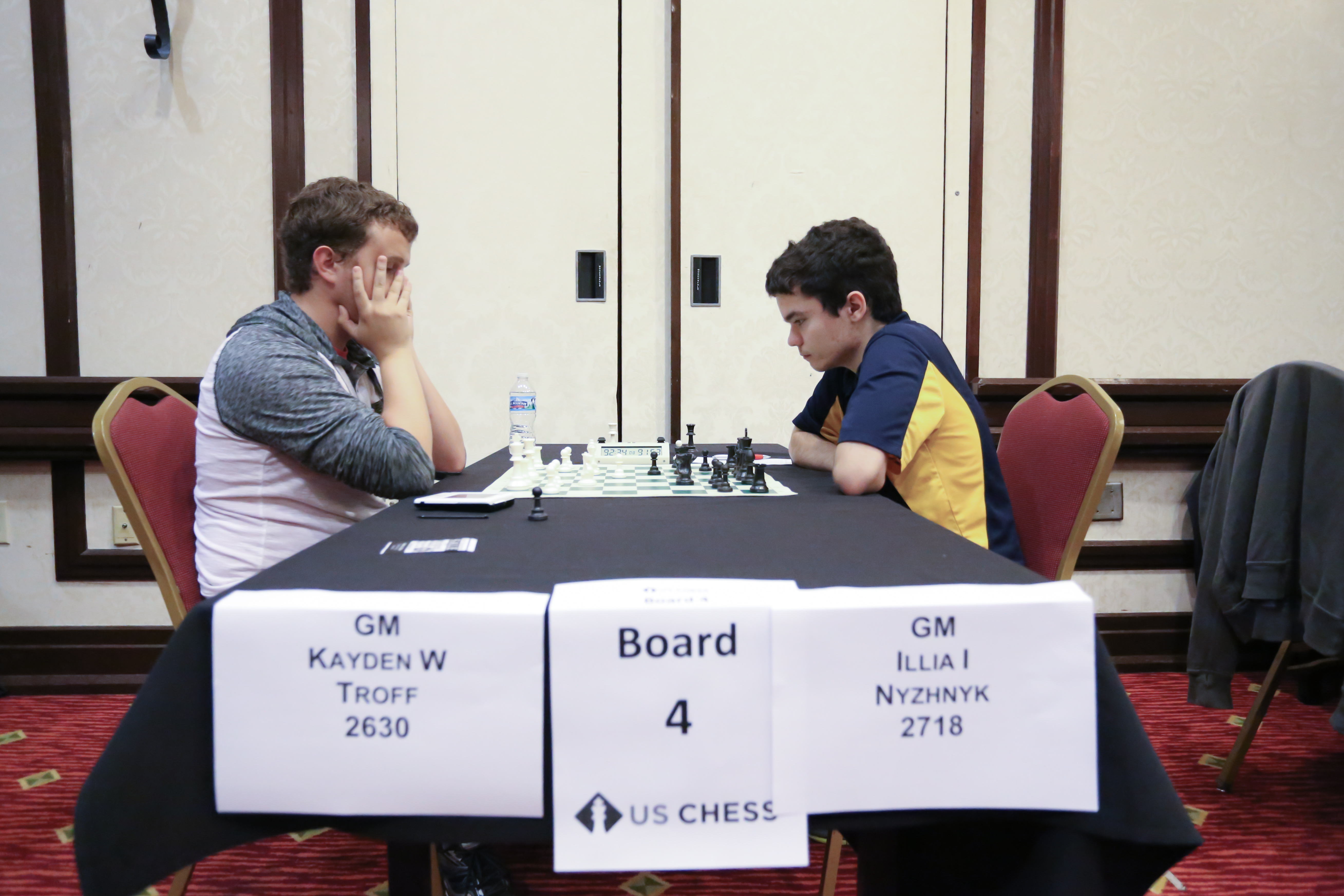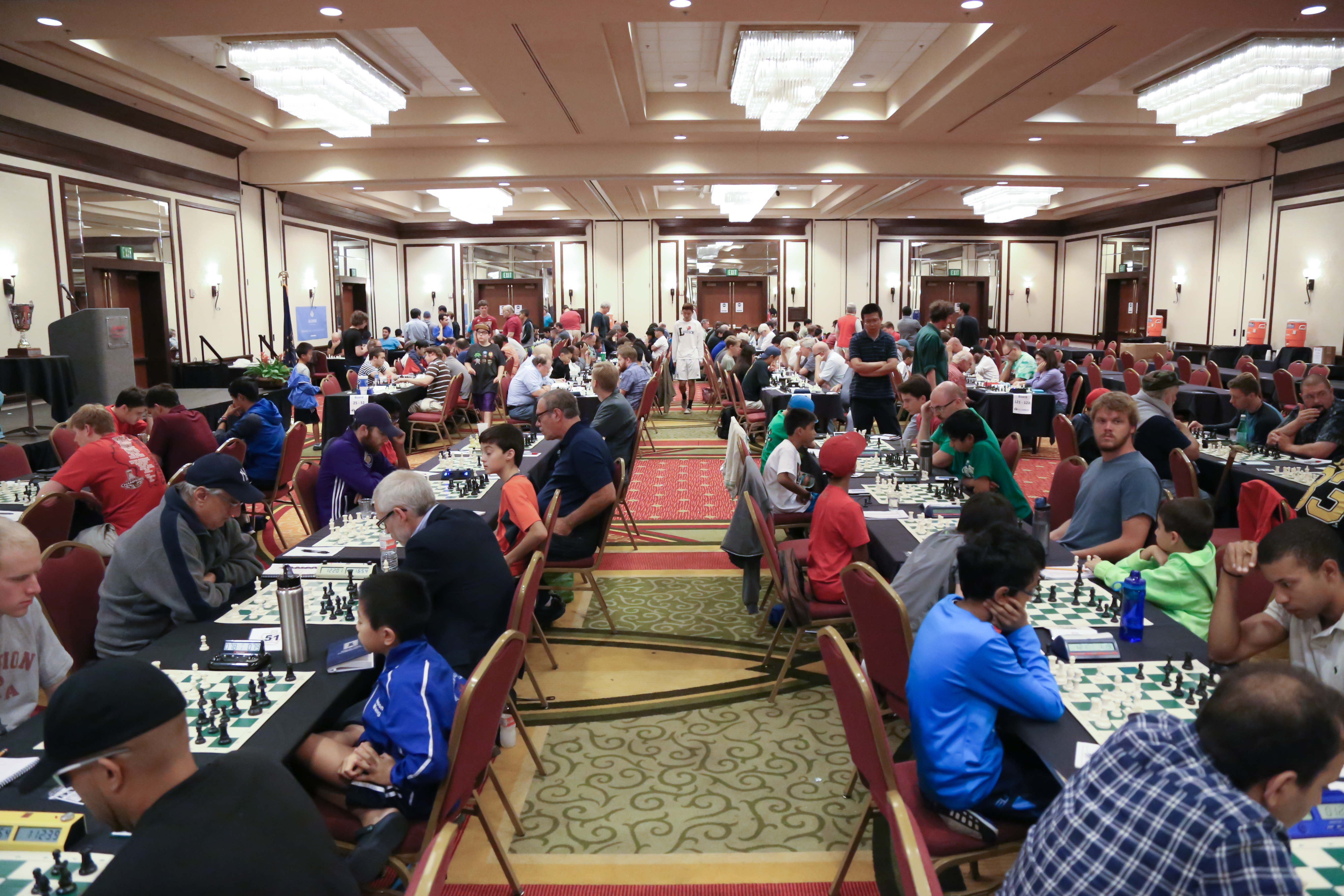 GM Aleksandr Lenderman vs. GM Alexander Shabalov, Photo Anne Buskirk
GM Aleksandr Lenderman vs. GM Alexander Shabalov, Photo Anne Buskirk
The 117th Annual US Open saw 389 participants compete across the nine, six, and four-day schedules. But when the dust settled Sunday night, only two stood atop the standings: Grandmasters Gil Popilski and Alexander Shabalov. Both reached their score of eight in different ways: Shabalov suffering a loss to IM Zurab Javakhadze in round five while Popilski took a first round bye and drew GM Ilia Nyzhnyk in round six.
Shabalov also won the playoff for the official US Open title and earns a coveted spot in the 2017 US Chess Championship.
[pgn] [Event "2016 US OPEN, DENKER, BARBER, NGTOC"]
[Site "Indianapolis, Indian"]
[Date "2016.08.07"]
[Round "Armageddon"]
[White "Shabalov, Alexander"]
[Black "Popilski, Gil"]
[Result "1-0"]
[WhiteELO "2634"]
[WhiteTitle "GM"]
[BlackELO "2642"]
[BlackTitle "GM"]
[Source "MonRoi"]
1.e4 c5 2.Nf3 e6 3.d4 cxd4 4.Nxd4 a6 5.Bd3 Bc5 6.Nb3 Be7 7.f4 d6 8.Be3 Nd7 9.N1d2 Ngf6 10.g4 h6 11.Qf3 g5 12.e5 dxe5 13.fxg5 hxg5 14.Bxg5 Rg8 15.h4 Nd5 16.Ne4 f6 17.Bh6 Nf4 18.O-O-O Qc7 19.Kb1 Nb6 20.Bxf4 exf4 21.g5 f5 22.Qh5 Kf8 23.Qh6 Ke8 24.Be2 Bd7 25.Nf6 Bxf6 26.Qxf6 1-0[/pgn]
IM Ruifeng Li and GM Fidel Corrales-Jiminez finished in the second score group, both on 7.5/9.
 GM Troff vs. GM Nyzhnyk, Photo Anne Buskirk
GM Troff vs. GM Nyzhnyk, Photo Anne Buskirk
The tournament was held at the Indianapolis Marriott East and apart from the main event also featured daily side events, including a weekend Swiss, daily quads, a game-15 championship, and a blitz championship. GM Timur Gareev also gave a blindfold exhibition and lecture.

After defeating GM Joel Benjamin in the 9th round, Gil Popilski could only wait and watch to see if anyone would match his 8 points. The critical game occurred between Shabalov and GM Aleksandr Lenderman, which is annotated below as our final game of the day.
[pgn]
[Event "2016 US OPEN, DENKER, BARBER, NGTOC"]
[Site "Indianapolis, Indian"]
[Date "2016.08.07"]
[Round "9"]
[White "Lenderman, Aleksandr"]
[Black "Shabalov, Alexander"]
[Result "0-1"]
[ECO "D12"]
[WhiteElo "2700"]
[BlackElo "2634"]
[Annotator "Karagianis,Pete"]
[PlyCount "92"]
[EventDate "2016.??.??"]
[Source "MonRoi"]
{This final round encounter ultimately decided the US Open Championship, as it
put Shabalov into a tie with GM Gil Popilski, who he then defeated in an
Armageddon playoff.} 1. c4 c6 2. d4 d5 3. Nf3 Nf6 4. e3 Bf5 5. Nc3 e6 6. Nh4
Be4 {Provoking f3 before acquiescing to the exchange of the bishop.} 7. f3 Bg6
8. Qb3 b5 9. cxd5 (9. cxb5 c5 {Is the idea, should white capture the other way.
A pawn sac which leads to a sharp position.}) 9... exd5 {Interestingly enough,
white has yet to win a game in this position in my database. He will, of
course, have the two bishops. And it's hard to believe that white is worse.
But practical play scores well for black.} 10. g3 Bd6 11. Bg2 {Entering into
unexplored territory.} (11. Bd2 {was Delmarre-Vogel, 2009.1/2-1/2.}) 11... O-O
12. Nxg6 hxg6 13. O-O Nbd7 14. Bd2 Re8 {Black had alternatives, but with this
move, Shabalov sets forth a very clear, simple, and straightforward plan: he
intends to play c5, whereafter if white captures, black will mount pressure
against the e3 pawn. Should white not capture, black will take over space on
the queenside.} 15. Kh1 {Perfectly reasonable to tuck the king away, but white
doesn't seem to have a direct plan.} b4 16. Na4 c5 17. dxc5 (17. Rfe1 Rc8 (
17... c4 {is possible, but it is not necessary to commit to this move just yet.
}) 18. Rac1 a5) 17... Nxc5 18. Nxc5 Bxc5 19. Rfe1 Qb6 20. Rad1 Re7 {e3 is
exposed.} 21. Bc1 a5 22. Rd3 Rae8 {black is fully mobilized. Objectively, the
position is still roughly equal, but the white bishops do not paint a pretty
picture. The c1 bishop is extremely limited, unless white is able to play e4
(impossible at the moment) and the g2 bishop can go to h3 or f1, but then what?
} 23. a4 Qa7 24. Re2 {White's position is very passive, but can black break
through?} Bb6 25. Bh3 Qa6 26. Qd1 g5 27. Bf1 Qa7 28. b3 g4 {Attempting to poke
more holes in the position.} 29. Bg2 (29. fxg4 {allows a dangerous knight jump:
} Ne4 30. Bd2 {White is all tied up. Black now has a variety of options, but I
personally prefer:} Qd7 {when the pawn will be retaken as it is not possible
to guard it:} 31. Bh3 (31. h3 Nxg3+) 31... Nc5 32. Rd4 Nxb3 {White collapses.})
29... d4 {Black does find a breakthrough.} 30. e4 gxf3 31. Bxf3 Nxe4 {The
passed d4 pawn is a serious issue, but white's pieces also remain less than
ideal.} 32. Kg2 Nc3 33. Rxe7 Qxe7 34. Qc2 Qe6 35. Bd2 Ne4 36. Qd1 Nc3 37. Qc2
Rc8 38. Bxc3 ({Capturing on c3 appears to be an unfortunate necessity as there
is no comfortable way to sidestep the discovery. For example:} 38. Qb2 Qf5 {
! And the queen will have to go right back to the c-file.}) 38... bxc3 39. Rd1
{The two passed pawns will be decisive.} Re8 40. Rf1 g6 41. Rc1 Re7 42. Qd1 Bc5
43. Bg4 Qe3 44. Rc2 d3 {Black converts/cashes in nicely.} 45. Rxc3 Qf2+ 46. Kh3
f5 {Clearing the way for Rh7.} 0-1 [/pgn]
Find full final standings here.
 GM Aleksandr Lenderman vs. GM Alexander Shabalov, Photo Anne Buskirk
GM Aleksandr Lenderman vs. GM Alexander Shabalov, Photo Anne Buskirk  GM Troff vs. GM Nyzhnyk, Photo Anne Buskirk
GM Troff vs. GM Nyzhnyk, Photo Anne Buskirk After defeating GM Joel Benjamin in the 9th round, Gil Popilski could only wait and watch to see if anyone would match his 8 points. The critical game occurred between Shabalov and GM Aleksandr Lenderman, which is annotated below as our final game of the day.
After defeating GM Joel Benjamin in the 9th round, Gil Popilski could only wait and watch to see if anyone would match his 8 points. The critical game occurred between Shabalov and GM Aleksandr Lenderman, which is annotated below as our final game of the day.







